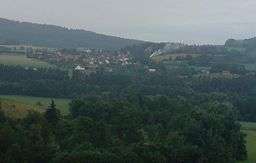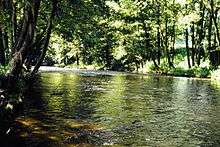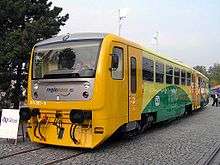Lčovice
| Lcovice | |
| Village | |
 Lčovice from a distance | |
| Country | Czech Republic |
|---|---|
| Region | South Bohemian |
| District | Prachatice |
| Municipality | Lcovice |
| Population | 150 |
| Mayor | Jindřiška Kalousová |
| Timezone | CET (UTC+1) |
| - summer (DST) | CEST (UTC+2) |
| Postal code | 38481 |
| Wikimedia Commons: Lcovice | |
| Statistics: http://www.statnisprava.cz/rstsp/ciselniky.nsf/i/561649 | |
Lcovice is a village in South Bohemian Region of the Czech Republic with a population of 150 inhabitants. Historically the village expanded in a way that today it is built in two area and connected by a road. It is famous settlement and hundreds of tourists visit the village every year. Not only are they attracted to the unique geography of the area but also to visit the home of Zdeněk Novotný living here and also go on a tour of the Baroque Palace.
History
The earliest historical mention of Lčovice is from 1321, when states of some Zbraslav Lčovice (Sbraslao de Ebizouiz). In place of the present castle was built during the Gothic fortress.
This section is currently a work in process
The Novotný family
Lčovice is the birthplace of Zdeněk Novotný. Born on 15 December 1925, he was one of eleven children to Václav and Anna Novotný. Zdeněk lived on the family farmhouse until his teens when he joined the partisans during World War II, then joined the army serving as a driver and assistant to the Generals quarters in Tábor. Zdeněk was an anti-communist so when communism took over Czechoslovakia in 1949 he fled to Germany and lived under a false name, then lived in Italy for a short time under another false name, and then immigrated to Australia by boat arriving with two British pounds in his pocket and not understanding a word of English. Zdeněk had one daughter (Robynanne Novotny) and one grandson (Anton Roberte-Novotny), he remained in Australia with almost no contact with his family in Czechoslovakia until 40 years later just before the Velvet Revolution.
The Novotny family came into possession of their property in the 17th century when an ancestor 'whom was a carriage driver for the royal family' fell in love with a princess and received the land and the farm house as a gift. The land was later confiscated by the communist party.
Baroque Palace
Lčovice's most famous physical landmark is its castle, also known as a Baroque Palace, One of the most famous owners was the architect Joseph Zitek, builder of the National Theatre (Prague). The whole area of the castle and the adjacent farm buildings are all protected as a cultural monument.
The castle is a two-story building of irregular plan, with early Baroque arcaded façade. Floor plan of the main building of the castle is mostly made up of the original Gothic fortress with 2m of heavy masonry. In main entrance on the left side of the staircase is a preserved pointed Gothic portal. The gateway dates from the early 19th century. The northern corner of the castle is connected to ten-storey annexe with baroque arched ground floor.
The area around the castle, which was founded in 1660, has an octagonal, baroque chapel (1669) topped dome and lantern, decorated with painted stucco rich. Octagonal Pavilion.
Today the building of the castle and park adjacent to private property and is not normally open to the public. Castle and Park are listed buildings.
Geography

Lčovice is famous around the Czech Republic because of its unique settlement pattern. Lcovice s actually two villages which are connected via a road as well as a footpath. The first (and original) village is located on the hillside at a height of 516m. This village known locally as 'the upper area', has beautiful, yet typical, Czech architecture. The square of the village is home to a 400-year-old lime tree which is one of the oldest trees in the area.
The second village known as 'the lower area' is located one kilometre away at the bottom of the valley next to the Volyňka river. Summer cottages started to appear here when the castle was no longer required to protect them, they were closer to the Lčovi
ce train station and land was easy to build on due to the flood plain of the Volyňka river. Farming methods also improved so this flatland around the river was no longer needed for fields as crops could now be grown on steep land. Detached housing is common in the lower area and the architecture is obviously more modern than upper. Lower Lčovice is located between Čkyně and Malenice and is within the surroundings of the UNESCO heritage listed Šumava national park.
Volyňka

The Volyňka river begins on a hill called Světlá hora and flows 46.1 km North-east to a town called Strakonice, where it merges with the Otava River. The Volyňka river flows through Lčovice and was used for drinking, washing clothes and provided a source of power to the two mills located in Lčovice.
In the modern day it is still used to swim in by the locals, as it provides a refreshing bath. It is very clean because it is still in the upper course of the river and so hasn't been polluted by large cities. It is also commonly used by fishermen who not only catch fresh-water fish, but the water is also used in ponds where carp is found for Christmas time. There are two watermills in Lčovice which can be seen on the diagram above. These however are no longer in use, but the mill still remains as a historical monument today.
Weather and climate
Much like the rest of the Czech Republic, Lčovice has a temperate continental climate, with relatively hot summers and cold, cloudy and snowy winters. Most rain falls during the summer. The temperature difference between summer and winter is relatively high, due to the landlocked geographical position.
The coldest month in Lčovice is usually January, followed by February and December. During these months, there is usually high snowfall. During March, April and May, the temperature usually increases rapidly, especially during April, when the temperature and weather tends to vary widely during the day. Spring is also characterised by high water levels in the Volyňka, due to melting snow with occasional flooding.

The warmest month of the year is July, followed by August and June. On average, summer temperatures are about 20 degrees higher than during winter. Especially in the last decade, temperatures above 30 °C are not unusual. Summer is also characterised by rain and storms.
Autumn generally begins in September, which is still relatively warm and dry. During October, temperatures usually fall below 15 °C and deciduous trees begin to shed their leaves. By the end of November, temperatures usually range around the freezing point.
Infrastructure
Transport:
The village of Lčovice has its own railway station located in lower. This railway (track 198) was built in 1850 and runs from Volary to Strakonice. When this railway was first completed there was major complaints from residents about the loud noise produced by the steam engine. Although these critics quickly realised this was a small price to pay, as they now were connected with many other villages which meant they could trade with each other far easier than before the railway. People could now travel to different places in a relatively short time, whereas previously a trip to a big town or city like Prague would have been a two-day horse ride.
In the modern day the railway has services which run throughout the day, although there have been fears the railway will be closed, it provides major tourism for the region of South Bohemia, and in Winter where skiers travel to Kubova Huť which had amazing ski slopes.

In June 2009 there was heavy rainfall which damaged the train line, and the section from Malenice to Čkyně was closed for repairs. The Lčovice train station was servilely damaged, due to the surface run-off from the hillside above. The České dráhy (Czech railways) got money from the European Union to rebuild the track and prevent future damage. A large platform was then built with a drain to allow the water to escape without affecting the track. The platform has been heavily objected by criticism from villagers stating that it ruins the typical village train station 'feel' and looks more like that of a large city train station. Many large towns on the 198 route also do not have any platforms so it does seem strange that Lčovice has this. The one advantage it does provide however is easy access is for pensioners and people with disabilities, as there is no need to climb up to the train as previously.
Other than the train station is the Route 4 road which runs along the valley above upper. This is connected to upper and lower via a smaller road. Route 4 goes directly to Prague. So this provides quick access to the village and encourages tourism.
Other transport services include three bus stops, one located on the main road (Route 4) one in the middle of upper Lčovice and one for the lower residents located next to the train station. Buses travel through these stops throughout the day.
Cycle route 1233 runs right through lower Lčovice.
Canalisation:
All cottages have 230v electricity, even the remote houses which are isolated. Currently work is under way to hide all electric cables underground. This means they are safer, and don't ruin the landscape.
Lčovice does not currently have its own sewage system, although there have been plans to create this, it has never been turned into reality. It would be possible to connect to the sewage system of Čkyně however there are disagreements between the two villages so this will unlikely happen. This means villages have to rely on their own septic tank. It is now the law that dry toilets are no longer allowed due to hygiene reasons. However many people have been unwilling to opt for the expensive septic tank option as they are not sure if the village will get its own sewage system in the future, in which case the septic wouldn't be a sensible economic option.
Lčovice like the sewage situation does not currently have water piped to the village. Most cottages rely own their own well which is connected to a pump so they get water from the tap this way. Previously it was advised not to drink the water due to dry toilets leaking into the wells and contaminating the water. This is still currently the case in upper Lčovice, (and residents bought bottled water) but has significantly improved and there is speculation that the water is perfectly safe. This issue of contaminated water is found only in upper Lčovice where houses are close together and some houses share the main village well.
However, in lower Lčovice this problem almost non-existent, as they are more modern housing and so when built this was taken into account and all houses were built with a septic included. Also because the houses are well dispersed and there is clean water which is collected in the bottom of the valley from Věnec.
In terms of shops and other services, there used to be a local shop which sold fresh rolls in the morning as well as milk and other items. Although this is now closed as it was no longer subsidised. This means locals now have to travel to other villages like Malenice (as they're minted and can afford to pay to keep it) and Čkyně. They can also walk up to the petrol station (read more below) however this walk involves crossing the dangerously busy Route 4 road. The original shop was closed and opened into a pub, for a few years but has now, like the shop, closed down. There is a kiosk in lower Lčovice which is a pub, where you can sit outside next to the Volyňka and is perfect after a long walk (or a refreshing drink after cycling on the 1233 cycle route). Originally there used to be a school in the village but was closed and is now the major's offices where all meetings and discussions about the village take place.
Tourism
The village sees hundreds of visitors every year, many of the tourists come by bike while cycling along the 1233 cycle route. They are encouraged to stop in the village with pubs for a refreshment, and here they can learn about the vast history of Lčovice.
2002 flooding
In August 2002 a 100-year flood caused by over a week of continuous heavy rains ravaged Europe killing dozens, dispossessing thousands, and c

ausing billions of Euros' worth of damage. Czech Republic was badly affected including Lčovice. Problems here were caused to lower residents who lived on the flood plane, upper obviously remained unaffected. Many residents had to be evacuated from the area and were not allowed to return to their home until the water level had returned to normal.
After the flood, the environmental effects where noticeable. Bare patches alongside the river where trees had been ripped out and carried away. As well as flatted plants and dead fish and other animals. It has been estimated that the ecosystem around the Volyňka took five years to return to normal. The human effects were also clear. Although the main bridge which provides road access between L1 and L2 was saved, a smaller wooden bridge (part of the 122 cycle route) was destroyed which was a significant landmark in Lčovice. Summer cottages were saved thanks to the design of them in L2 which are designed to withstand the forces of the river.
Věnec
In the south of the village lies the Věnec Hill which its highest point is 765m. It is notable for the remains of a Celtic fort from the time of the late Hallstatt and La Tène. The erection of the fort dates back to the 5th century. BC. It is part of the cultural heritage and is illegal to remove any part of remains of the accent wall.
The Věnec hill has been suspected to large areas being logged. As the area is privately owned, this cannot be controlled. This has caused an outrage as now the forest which covers Věnec, has become an eyesore, and will take many years to grow back to its original growth.
The yellow petrol station
In April 2005 petrol station opened on the Route 4 road right next to Lčovice. It has been heavily objected by local residents as because of its bright colours, it is extremely visible from far away, and causes a scar on the landscape. Blue neon lights also light up at night time which cause light pollution in the valley. It has however provided good amenities for the village as it is just a short walk up to the petrol station, such as WiFi, showers and toilets, a Café with hot food, and of course petrol!
Although business has been poor, and so to encourage more people to go to the there, since 2008 music concerts have been held every year since. In 2008 Nazareth was booked to perform, and was a great success, with tickets sold out and people using the petrol stations services.
In 2009 Slade performed and although this wasn't as popular as the previous year, people still came and enjoyed the experience. Many onlookers sat around the petrol station who refused to buy tickets.
In 2010 Smokie performed which was poorly received. It is unsure whether there will a future concert.
These performances have helped put Lčovice on the concert map
Church Chapel
Shop which closed fire engine shed repaired
External links
- Official website (Czech)
- Lčovice chateau (Czech)
- Lčovice at portal.gov.cz (Czech)
Coordinates: 49°07′N 13°51′E / 49.117°N 13.850°E
| Wikimedia Commons has media related to Lčovice. |